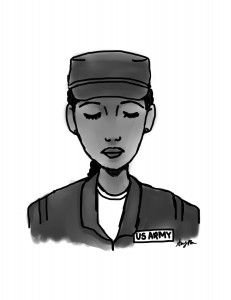
Two weeks ago, U.S. Secretary of Defense Leon Panetta ordered the removal of the military’s 1994 ban on women serving in combat positions. The notion of women serving alongside men in combat has been a topic of hot debate as experts argue over whether or not this progressive measure could prove to be a grave mistake.
We’ve seen it before. In fact, people have raised a fuss every time women have been allowed to do anything new, like owning property or voting in elections. The circumstances may be different, but it boils down to the same question: What kind of unimaginable chaos could break out if we let women into an arena that was previously reserved solely for men?
One of the main arguments against allowing women to serve in combat positions centers around concerns about physical strength. Simply put, can women realistically meet the physical demands required of them?
Yes. For one thing, women have been unofficially serving in combat positions for many years. For another, research has shown that biological differences between men and women — including that of bodily strength — are not as pronounced as society tends to believe. In fact, the essence of male/female differences are often more a product of nurture rather than of nature. Although men may be generally bigger and stronger, it does not mean that all men are naturally stronger than women. Thus, a blanket ban on females serving in combat is not practical.
Another concern is the effect of integration on unit cohesion and efficiency. Critics said the same thing about the repeal of “Don’t Ask, Don’t Tell,” arguing that the military would lose combat efficiency if gay men and women were allowed to serve openly.
Did it? No.
The problem of sex is frequently debated here. To some, men plus women plus long hours in cramped quarters could only lead to bad things — sexual distractions, problems of privacy and the potential for more rapes.
The short response is that the possibility of sexual activity among soldiers is not reason enough to ban all women from serving in combat, just as it was not enough to prevent them from serving in the military. Furthermore, allowing women to serve in combat positions will ultimately increase their status and prestige in the eyes of their fellow soldiers, breaking down the military’s patriarchal nature and lending to fewer cases of sexual assault in the long run.
At the heart of this debate lies the belief that men and women are naturally and irreconcilably different and that putting them together in such an environment would be to the detriment of military forces. But recall that there was a day not too long ago when doctors advised women against entering the workforce for fear that it would cause irrevocable damage to their ovaries. The same arguments critics are making today have, in some form or another, been used throughout history to keep not only women but racial and sexual minorities out of areas where they were deemed “unfit.”
Hardly anyone today would disagree with having women in government. Females have made significant gains in institutions that were, once upon a time, reserved solely for males. Indeed, there was a day when women couldn’t participate in the military at all. But society has progressed. And we must continue to do so, rather than falling into the same traps as before.
To do so, we must examine the far more complex and deeply ingrained anxieties Americans harbor over what it means to be a man or woman.
In times such as this, we should not forget the reality that being born a male does not automatically make one an aggressive, stoic and combat-ready hero. Moreover, being born a female does not make one inherently unfit for such a role.
Instead of seeing soldiers with varying degrees of courage and skill, military leaders see men and women, routinely assuming that the latter are weaker and less fit for battle. This perspective is not only limiting, but it also plays a part in the overall devaluation of women in the military as well as the unacceptably high rates of sexual assault, violence and female subjugation.
I believe that disbanding the gender requirement for combat roles will greatly contribute to a breakdown of our military’s patriarchal nature, creating a more unified environment and a more successful military force overall.
It’s time to stop seeing gender, race or sexual orientation and start seeing one another as human beings. Allowing women to serve in combat positions is a small step in the right direction for American society.
—————————————————————————————————————————————
Follow The Graphic on Twitter: @peppgraphic

